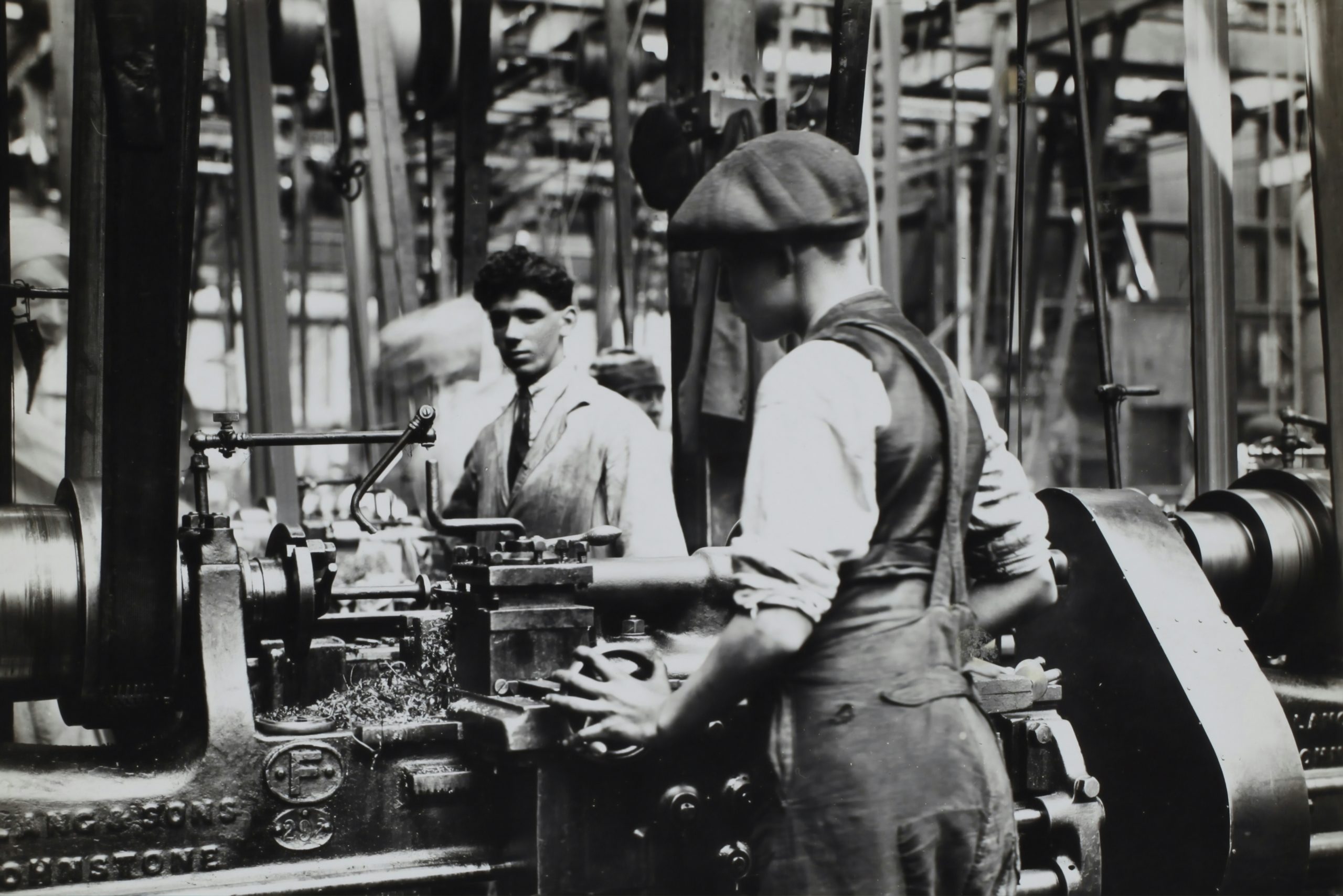The United Auto Workers is a labour union which represents auto workers in the United States as well as Southern Ontario.
The union was founded as a part of the Congress of Industrial Organizations, which was a federation of unions in the United States and Canada from 1935 until 1955.
Under the leadership of Walter Reuther, the UAW became a significant part of the Democratic Party.
The UAW was originally founded in May 1935 in Detroit, Michigan under the American Federation of Labour.
The UAW found success in organizing a sit-down strike in the General Motors Corporation plant in Atlanta, Georgia.
That strike would end in February of 1937, once the Governor of Michigan Frank Murphy worked as a mediator.
Auto Workers at Chrysler won recognition of the UAW and by mid 1937, the UAW had 150 000 members that had spread through multiple states in the midwest.
The Ford Motor Company was the next target of the UAW. Ford had long resisted unions in their plants. Henry Ford himself used force to keep unions out of Ford. He set up an espionage unit inside of Ford to spy on workers and used violence to persuade union organizing.
This resulted in a famous incident named Battle of the Overpass, which paired the Ford Motor Company against UAW members at the River Rouge complex in Dearborn, Michigan. Ford controlled the city government of Dearborn at this time and regularly used its police department to the company’s benefit.
Before the Battle of the Overpass, Fordworkers attempted to organize a peaceful Hunger March in 1932. Ford employee Henry Bennett brutally suppressed the march using his forces and Dearborn police. Five marches were killed and dozens injured by machine gun fire.
On the eve of the Battle of the Overpass UAW, Local 174 organized a leaflet campaign which was entitled “Unionism not Fordism ” this was located at the overpass above Miller Road at the River Rouge Plant.
Leaflets demanded a work day of 6 hours for $8 in contrast to the current Eight Hour Work Day of $6. The leaflets would be successful at GM, Chrysler, and Briggs Manufacturing Co.
At 2pm, members of the UAW posed for a photo for the Detroit News with the Ford sign in the background. While posing, members of the Ford Service Department attacked them.
The organizers were beaten with one member having his back broken. The brutal attack made news across the country. The National Labor Relations Board pursued a case against Ford in the aftermath of the incident.
It would take several more years until 1941 for the Ford Motor Company to agree to Collective Bargaining with the UAW.
The emergence of the Second World War would drastically change the UAW. The union pledged the war effort would not be disrupted by strikes. Auto factories were transformed to handle tank production.
Longtime UAW local leader Walter Reuther would be especially influential in the war and postwar years.
He first proposed setting up war production with a plan to produce 500 planes a day using the unused capacity of the auto industry.
Postwar Reuther changed his tone and organized a strike against GM demanding a 30% increase in wages without increasing the price of their cars.
The strike would carry out for 113 days when both sides agreed to a eighteen and a half cent pay raise.
This bold organizing would win Reuther the UAW Presidency the next year in 1946.
Reuter’s time as President of the UAW would be transformational. His goal was to fight for the welfare of the public at large. He fought to integrate the American Bowling League which previously excluded African-American bowlers. He viewed his time as President to be used to push for social change.
Reuther would keep his salary low despite other union Presidents making 3 to 4 times his wage. He did this to show solidarity with the workers he represented and declared that the success of the union was infinitely more rewarding than material goods.
By 1950 Reuther negotiated a contract with Gm named Reuther’s Treaty of Detroit. This was a five year contract which aimed at providing pensions and company-funded medical care to employees. Reuther believed workers deserve a lifelong pension due to their service at the company and with the union.
Reuther discovered a way to scare automakers. They would threaten to strike at only one company in order to let the others reap the benefits. The other two were likely to agree to a deal to prevent the same fate falling upon them.
When Ford offered employees either pension or wage increases Reuther put this strategy in action, To avoid a strike, Ford paid $20 million a year to pay for pension along with agreeing to wage increases. Chrylsyer was willing to match the $100 a month plan Ford agreed to for 30 years of service. Chrysler, though, refused to fund it fully. Reuther authorized a strike which lasted 104 days. Reuther became famous during this time for his phrase “Too old to work, Too young to die”.
Chrysler would give in after three months and a disastrous $1 billion lost in sales.
Gm negotiated a contract immediately looking to avoid Chrylsters fate. Their contract was fully funded, and included social security offering workers $125 a month.
The Treaty of Detroit made healthcare a primary part of labor contracts and contributed heavily to moving auto workers into the middle class. Home ownership became common among laborers following this development.
Reuther met with a number of Presidents during his time as leader of the UAW including Truman, Eisenhower, and Kennedy.
Reuther convinced Kennedy to create the Peace Corps after a meeting after a late-night campaign speech at the University of Michigan.
Reuther was a strong supporter of civil rights and matched with Dr. Martin Luther King Jr. in Selma, Birmingham, Montgomery, and Jackson.
Reuther arranged $160 000 for protestors’ release following King’s Letter from Birmingham Jail.
He would later help organize and finance the march on Washington and served on the board of directors for the NAACP.
Reuther would write to his fellow union members urging them to provide financial support for the Prayer Pilgrimage for Freedom in Washington D.C.
Reuther also visited Cesar Chavez, who was involved with the United Farm Workers. He declared the UAW would provide $7 500 a month to support the UFW strike fund.
Reuther also championed environmentalism as he organized the United Action for Clean Water Conference in Detroit which called for clean water in communities.
For Reuthers efforts, he was almost assassinated on a number of occasions. First when he was abducted from a party in 1938 by two masked gunmen. The next attempt, his window was blown open by a shotgun blast when Reuther was preparing a late night snack for himself. The blast hit his right arm and shattered his arm into 150 pieces. Reuther did not lose consciousness and declared the would-be assassin to be a “dirty son of a bitch.”
On May 9th 1970, Reuther and his wife died in an airplane accident.
He was posthumously awarded the Presidential Medal of Freedom in 1995 by President Bill Clinton.
Under Reuthers leadership, the UAW strongly supported both the New Deal under President Roosevelt and the Great Society under President Johnson.
The UAW saw a high of 1.5 million in membership in 1979. Their support for the first Earth Day ensured it was a success.
By 1980 the automotive industry was impacted heavily by the 1973 oil embargo and following the energy crisis.
Chrysler was near-bankruptcy in 1979 which forced the UAW to give up many of the benefits which it had worked decades to ensure.
By 1985, the Canadian division disaffiliated from the UAW and became the Canadian Auto Workers.
UAW aided in the auto industry rebound in the start of the 2000s. It hit a major obstacle within the Automotive industry crisis of 2008-2010.
Companies such as GM aimed to restructure the automotive industry to look more like wages that were for Japanese car manufacturers. Workers are non-union and paid $10 to $20 less than UAW workers.
The base starting salary was lowered to $15 an hour following the 2007 National Agreement. The UAW was forced to suspend its former jobs bank program, which helped laid-off employees following the auto industry crisis.
Another major issue was the Big Threes focus on SUVs and trucks, which were less popular following the 2003-2008 oil crisis.
The UAW would aid in the Covid-19 crisis when it partially shut down factories on a rotating basis in order to help combat spread of the virus.
The UAW would enter the spotlight once again in September of 2023, when it engaged in a strike against all of the big three. The strike began when the union was unable to reach a deal with the manufacturers. New UAW President Shawn Fain took a hardline approach to the strike, He criticized the automotive companies for stagnant wages which did not account for the rise of inflation.
He also criticized the automotive makers for not restoring benefits which were lost as result of the 2007-2008 financial crisis. He advocated for improved worker protections especially against plant closures and a four day workweek. Automotive producers were unwilling to meet Fain’s demands in a new contract which raised the possibility of a strike.
The vote to strike overwhelmingly passed on August 27 with 97 percent of members voting in favor. UAW announced they would strike against Ford, General Motors, and Stellaris at the same time. The union originally chose 3 plants based on profitability. They set a new deadline and announced if the needle did not move another round of plants would be chosen. This developed a new type of strike where workers struck at different points rather than all at once.
On September 22nd, the strikes expanded with 5 600 workers walking out of 38 distribution plants.
Biden announced his intention to visit Michigan on the 26th to join the picket line and stand in solidarity. On September 29, 7000 additional workers walked out of factories. The strike continued to expand on October 11th when 8700 members walked out of Ford’s Kentucky Truck Assembly and October 23rd when 6 800 workers walked out of Stellantis’s Sterling Heights Assembly. The next day, 5000 Gm workers joined the strike.
On October 25, as a result of the pressure the UAW put on Ford, they reached a tentative agreement. This would include a 11% wage increase in the first year and 25% increases over the 4.5 year contract duration.
There was also a $5000 ratification bonus and a cost-of-living adjustment where total pay could be raised by 30%.
Three days later, a similar agreement was reached by Stellantis.
GM did not agree initially and caused 4000 workers to walk out of Gm’s Spring Hill Manufacturing. A deal with GM would finally be struck on October 30th, resulting in all employees returning to work.
The contracts also eliminated the two-tier system of wages where newer workers and temporary workers were paid less. 82% of UAW members voted to ratify the agreement at Ford. 69% voted in favor of the Stellaris deal and only 54% voted in favor of the Gm agreement.
Following the agreement, the UAW announced it would try to organize workers in other plants other than the Big three.
Recently the UAW has endorsed President Joe Biden’s reelection campaign.
The UAW has had an incredible impact on modern history. They have fought for workers, civil rights, and pushed society forward into a more progressive reality. The UAW’s history should be celebrated as an incredible achievement and has carved out a spot for themselves in union and American history.





